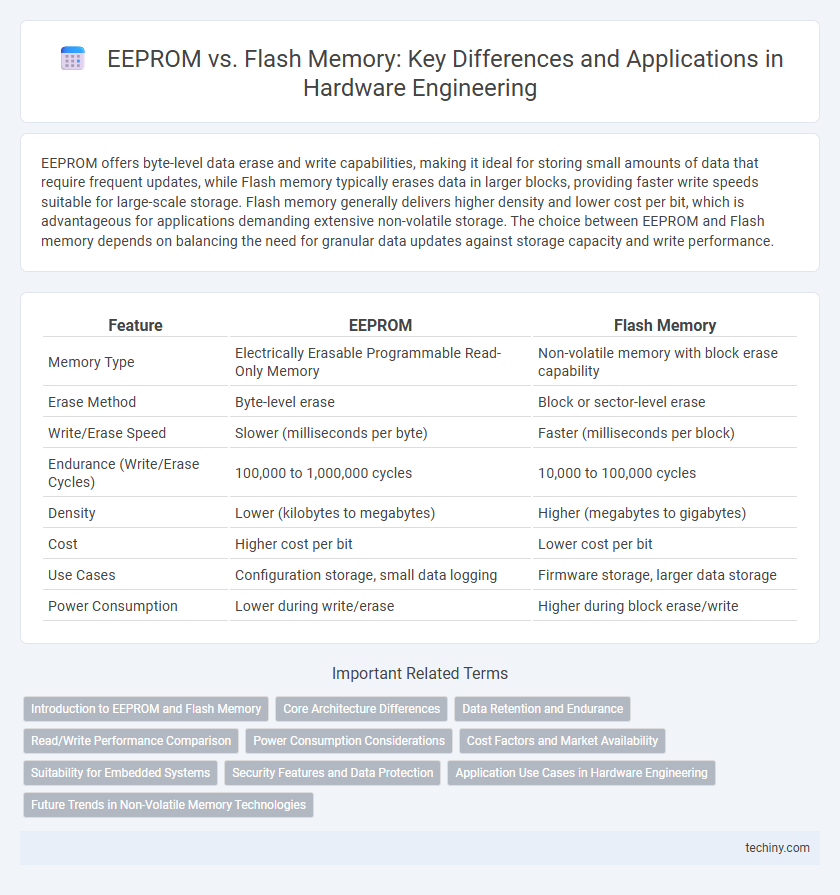EEPROM offers byte-level data erase and write capabilities, making it ideal for storing small amounts of data that require frequent updates, while Flash memory typically erases data in larger blocks, providing faster write speeds suitable for large-scale storage. Flash memory generally delivers higher density and lower cost per bit, which is advantageous for applications demanding extensive non-volatile storage. The choice between EEPROM and Flash memory depends on balancing the need for granular data updates against storage capacity and write performance.
Table of Comparison
| Feature | EEPROM | Flash Memory |
|---|---|---|
| Memory Type | Electrically Erasable Programmable Read-Only Memory | Non-volatile memory with block erase capability |
| Erase Method | Byte-level erase | Block or sector-level erase |
| Write/Erase Speed | Slower (milliseconds per byte) | Faster (milliseconds per block) |
| Endurance (Write/Erase Cycles) | 100,000 to 1,000,000 cycles | 10,000 to 100,000 cycles |
| Density | Lower (kilobytes to megabytes) | Higher (megabytes to gigabytes) |
| Cost | Higher cost per bit | Lower cost per bit |
| Use Cases | Configuration storage, small data logging | Firmware storage, larger data storage |
| Power Consumption | Lower during write/erase | Higher during block erase/write |
Introduction to EEPROM and Flash Memory
EEPROM (Electrically Erasable Programmable Read-Only Memory) enables byte-level data erasure and rewriting, making it ideal for storing small amounts of non-volatile data like configuration settings. Flash memory operates with block-level erase and write processes, offering higher density and faster performance suitable for mass data storage in devices such as SSDs and USB drives. Both technologies retain data without power but differ significantly in speed, write endurance, and typical applications within embedded systems and consumer electronics.
Core Architecture Differences
EEPROM features byte-level access with a floating-gate transistor architecture, enabling individual byte erase and write operations, which results in slower write speeds but higher precision. Flash memory uses block-level access with a similar floating-gate transistor design but requires erasing large blocks before rewriting, leading to faster write speeds and higher storage densities. The core architectural distinction is EEPROM's fine-grained byte erase capability versus flash memory's coarse-grained block erase process, affecting performance and application suitability.
Data Retention and Endurance
EEPROM offers superior data retention, typically maintaining information for over 20 years, making it ideal for applications requiring long-term storage without frequent writes. Flash memory provides higher endurance with write/erase cycles ranging from 10,000 to 100,000, supporting frequent updates but generally retains data for 5 to 10 years. Selecting between EEPROM and flash depends on balancing the need for durability in data retention against the demand for endurance in write cycles.
Read/Write Performance Comparison
EEPROM offers byte-level read and write capabilities with slower access times, making it suitable for frequent small data updates. Flash memory excels in higher read/write speeds and bulk data transfers due to block-level operations, optimizing performance for larger storage applications. The choice between EEPROM and Flash depends on balancing read/write speed needs with the granularity of data updates in embedded systems.
Power Consumption Considerations
EEPROM typically consumes less power during data write and erase cycles compared to flash memory, making it suitable for low-power applications and frequent small data updates. Flash memory, while offering higher storage density and faster write speeds, generally requires higher voltage and longer erase times, leading to increased power consumption. Selecting between EEPROM and flash memory depends on power budget constraints and the specific use case regarding data write frequency and storage requirements.
Cost Factors and Market Availability
EEPROM typically incurs higher manufacturing costs per bit compared to Flash memory due to its byte-level erase capability, which demands more complex circuitry. Flash memory benefits from economies of scale and widespread adoption in consumer electronics, making it more cost-effective and readily available across diverse market segments. The market availability of Flash memory is broader, with extensive supplier options and larger production volumes driving down prices relative to EEPROM.
Suitability for Embedded Systems
EEPROM offers byte-level erase and write capabilities, making it ideal for storing small amounts of configuration data in embedded systems requiring frequent updates. Flash memory, with its block-level erase and higher density, suits applications needing large code or data storage, balancing cost and performance. Both types provide non-volatile memory, but EEPROM's endurance and granularity favor fine-tuned data storage, whereas Flash supports efficient bulk storage in embedded designs.
Security Features and Data Protection
EEPROM offers byte-level data erasure and reprogramming, enhancing precise security updates and minimizing data exposure risks. Flash memory supports block-level erasure, which can limit granularity but often incorporates advanced hardware encryption and secure boot capabilities to protect large datasets. Both technologies utilize write-protection and error-correcting codes (ECC) to safeguard data integrity against unauthorized access and corruption.
Application Use Cases in Hardware Engineering
EEPROM is ideal for applications requiring frequent small data updates, such as calibration settings or configuration parameters in embedded systems, due to its byte-level erase and write capability. Flash memory excels in scenarios demanding large data storage and infrequent updates, commonly used for firmware storage and bootloader code in microcontrollers and hardware devices. Hardware engineers choose EEPROM for non-volatile memory with limited write cycles and Flash memory when balancing cost, density, and speed in mass storage.
Future Trends in Non-Volatile Memory Technologies
Emerging non-volatile memory technologies are rapidly bridging the gap between EEPROM and flash memory by combining high endurance with greater storage density. Innovations like Resistive RAM (ReRAM) and Magnetoresistive RAM (MRAM) provide faster write speeds and lower power consumption, addressing the limitations of traditional EEPROM and flash memory. These advancements are poised to transform hardware engineering by enabling more reliable, energy-efficient, and scalable memory solutions for future embedded systems and IoT devices.
EEPROM vs Flash Memory Infographic

 techiny.com
techiny.com